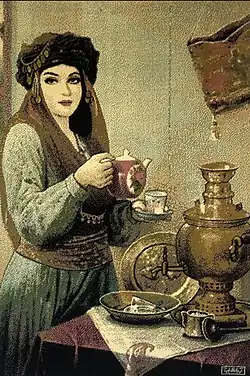Mukriyan
Mukri Emirate[1] موکڕیان | |||||||||
|---|---|---|---|---|---|---|---|---|---|
| c. 1400–c. 1800 | |||||||||
| Capital | Mahabad[2] | ||||||||
| Common languages | Sorani Kurdish | ||||||||
| Religion | Shafiʽi Sunni Islam[3] | ||||||||
| Government | Monarchy | ||||||||
| History | |||||||||
• Established | c. 1400 | ||||||||
• Dissolved | c. 1800 | ||||||||
| |||||||||
Mukriyan (Kurdish: موکڕیان) or 'Deryaz'[4] was a Kurdish principality from the late 14th century to the 19th century centered around Mahabad.[5] Mukriyan was a neighbor to the Emirate of Bradost.[6]

Geography and tribes
Mukriyan encompassed the area south of Lake Urmia, including the cities of Mahabad, Piranshahr, Oshnaviyeh, Sardasht and Bukan[7] with the city of Naqadeh historically being included in Mukriyan,[8] though today Kurds only make up approximately 35% of the city.[9] The city of Saqqez is culturally very similar to Mukriyan, though politically it acted more as its own city-state.[10]
A few tribes include Dehbruki, Gewirk, Mangur (tribe), Mukri, Amireh, Khelki, Sheikh Sherefi, Selekei, Ḥasan Khāli, Kārish, Silki, Sekir, Fekiyesi, Ables, Bārik, Soleimāni, Beyi, Omerbil, Merzink, Lētāu Māwet, and Shiwezāi.[11][12]
History
Before Mukris, the region was ruled by Hadhabanis, the region is also in the same, or similar, location as Mannea and Takht-e Soleymān. During the battle of Dimdim, Mukriyanis rallied around Kurds of Bradost.[13] Abbas I of Persia married a Mukri noblewomen in 1610 AD following the execution of her brother, Bodagh Soltan, during the defeat of the Mukri at the battle of Dimdim.[14][15]
See also
References
- Meiselas, Susan (1997). Kurdistan. Random House. ISBN 9780679423898.
- Hassanpour, Amir (1989). "BŪKĀN". Encyclopedia Iranica. IV.
- Rosskeen Gibb, Hamilton Alexander (1954). The Encyclopaedia of Islam (Volume 4 ed.). Brill. pp. 188–192.
- Eagleton, William (1963). The Kurdish Republic of 1946. The University of Michigan: Oxford University Press. pp. 26–27.
- Hassanpour, Amir (1989). "BŪKĀN". Encyclopedia Iranica. IV.
- Hassanpour, Amir (1988). "BARĀDŪST". Encyclopedia Iranica. III.
- "Obesity consequences from the people's perspective living in Kurdish regions of Iran: A qualitative content analysis". August 2019. doi:10.4103/jehp.jehp_13_19 (inactive 1 August 2023).
{{cite web}}: CS1 maint: DOI inactive as of August 2023 (link) - Minorsky.
- Franz, Erhard (1981). Minderheiten in Iran: Dokumentation zur Ethnographie und Politik. Deutsches Orient-Institut, Dokumentations-Leitstelle Moderner Orient. p. 39. ISBN 9783886930081.
- "Saqqez - Language distribution: Kordestan Province". Iran Atlas. Retrieved 13 May 2021.
- Minorsky, Vladimir (1957). "Mongol Place-Names in Mukri Kurdistan (Mongolica, 4)". Cambridge University Press. 19 (1): 68 & 73. JSTOR 609632 – via JSTOR.
- Rawlinson, Henry. Mukriyans. p. 34.
- DIMDIM Archived April 25, 2006, at the Wayback Machine
- Butler, Herbert (2012). Sir Thomas Herbert, Bart: Travels in Africa, Persia, and Asia the Great : Some Years Travels Into Africa and Asia the Great, Especially Describing the Famous Empires of Persia and Hindustan, as Also Divers Other Kingdoms in the Oriental Indies, 1627-30, the 1677 Version. Medieval & Renaissance Texts & Studies. ACMRS (Arizona Center for Medieval and Renaissance Studies). p. 403. ISBN 978-0-86698-475-1.
- American Society of Genealogists. 1997. p. 244.
Sources
- Minorsky, "Suldūz", Encyclopedia of Islam, Second Edition, doi:10.1163/1573-3912_islam_SIM_7169
Further reading
- Hassanpour, Amir (1980). Notes on social structure of Mukriyan, the history of mullas in Mukriyan genealogy of land lords, material in Persian and English.